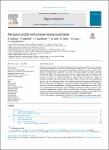Advances in QED with intense background fields
| dc.contributor.author | Fedotov, A | |
| dc.contributor.author | Ilderton, A | |
| dc.contributor.author | Karbstein, F | |
| dc.contributor.author | King, Ben | |
| dc.contributor.author | Seipt, D | |
| dc.contributor.author | Taya, H | |
| dc.contributor.author | Torgrimsson, G | |
| dc.date.accessioned | 2023-04-17T10:09:45Z | |
| dc.date.available | 2023-04-17T10:09:45Z | |
| dc.date.issued | 2023-02-27 | |
| dc.identifier.issn | 0370-1573 | |
| dc.identifier.uri | https://pearl.plymouth.ac.uk/handle/10026.1/20697 | |
| dc.description.abstract |
Upcoming and planned experiments combining increasingly intense lasers and energetic particle beams will access new regimes of nonlinear, relativistic, quantum effects. This improved experimental capability has driven substantial progress in QED in intense background fields. We review here the advances made during the last decade, with a focus on theory and phenomenology. As ever higher intensities are reached, it becomes necessary to consider processes at higher orders in both the number of scattered particles and the number of loops, and to account for non-perturbative physics (e.g. the Schwinger effect), with extreme intensities requiring resummation of the loop expansion. In addition to increased intensity, experiments will reach higher accuracy, and these improvements are being matched by developments in theory such as in approximation frameworks, the description of finite-size effects, and the range of physical phenomena analysed. Topics on which there has been substantial progress include: radiation reaction, spin and polarisation, nonlinear quantum vacuum effects and connections to other fields including physics beyond the Standard Model. | |
| dc.format.extent | 1-138 | |
| dc.language | en | |
| dc.publisher | Elsevier BV | |
| dc.title | Advances in QED with intense background fields | |
| dc.type | journal-article | |
| dc.type | Review | |
| dc.type | Journal | |
| plymouth.volume | 1010 | |
| plymouth.publication-status | Published | |
| plymouth.journal | Physics Reports | |
| dc.identifier.doi | 10.1016/j.physrep.2023.01.003 | |
| plymouth.organisational-group | |Plymouth | |
| plymouth.organisational-group | |Plymouth|Faculty of Science and Engineering | |
| plymouth.organisational-group | |Plymouth|Faculty of Science and Engineering|School of Engineering, Computing and Mathematics | |
| plymouth.organisational-group | |Plymouth|REF 2021 Researchers by UoA | |
| plymouth.organisational-group | |Plymouth|Users by role | |
| plymouth.organisational-group | |Plymouth|Users by role|Academics | |
| plymouth.organisational-group | |Plymouth|REF 2021 Researchers by UoA|UoA10 Mathematical Sciences | |
| plymouth.organisational-group | |Plymouth|REF 2021 Researchers by UoA|ZZZ Extended UoA 10 - Mathematical Sciences | |
| plymouth.organisational-group | |Plymouth|Users by role|Researchers in ResearchFish submission | |
| dcterms.dateAccepted | 2023-01-30 | |
| dc.date.updated | 2023-04-17T10:09:39Z | |
| dc.rights.embargodate | 2023-4-18 | |
| dc.rights.embargoperiod | forever | |
| rioxxterms.versionofrecord | 10.1016/j.physrep.2023.01.003 |


